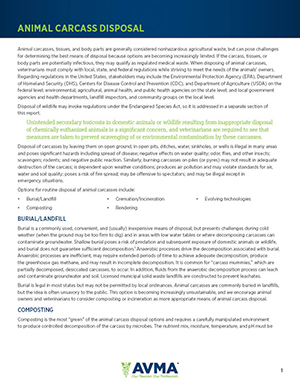Animal carcass disposal

Animal carcasses, tissues, and body parts are generally considered nonhazardous agricultural waste, but, because options are becoming increasingly limited, disposal can pose challenges. This animal carcass disposal guide for AVMA members can help you determine the best means of disposal.
When disposing of animal carcasses, veterinarians must comply with local, state, and federal regulations while striving to meet the wishes of the animals’ owners. If the carcass, tissues, or body parts are potentially infectious, they might qualify as regulated medical waste.
In the U.S., regulations regarding disposal are set by a variety of stakeholders on the local, state, and federal levels. In order to prevent secondary harm to domestic animals or wildlife due to inappropriate disposal, certain methods of disposal may be illegal in many areas.
Options for routine disposal of animal carcasses include:
- Burial/landfill
- Composting
- Cremation/incineration
- Rendering
- Evolving technologies
Member guide
The AVMA animal carcass disposal guide is a free, downloadable resource for AVMA members that discusses these disposal options and how they apply to remains of domestic animal species as well as wildlife casualties.
Policy
Appropriate animal carcass disposal
The AVMA advocates safe and environmentally responsible disposal of animal carcasses.
Resource
Companion animal aftercare
Pet owners rely on veterinarians to select trustworthy aftercare providers and handle pet remains safely.
Animal welfare: Humane endings
Learn about veterinarians’ responsibility to animals during final life stages: end of life, human perspectives, humane killing techniques, disposal of remains.
